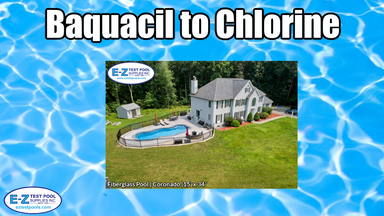Published by EZ Pool & Spa Supply on 05/17/2017
Switching Your Pool from Baquacil to Chlorine
Switching Your Pool from Baquacil to Chlorine
Baquacil, the chemical trade name of a non-chlorine pool system, is a product used by a fairly small percentage of pool owners to sanitize their pools. The main active ingredient in this system is biguanide (the generic chemical name), and you may see this type of chemical sold under the names Baquacil, Revacil, Soft Swim or other lesser known brand names. The lure of a product like this is typically that there is no chlorine in the pool, very little odor from the chemical and much less fading occurring to vinyl liners and swimsuits.
As I’ve seen, many people seem to have good luck with this product for the first year or two before running into problems that become increasingly difficult and costly to cure. Add this to the fact that the yearly operating cost of chemicals (even without problems) for a biguanide pool is often several times that of a chlorine pool and you can see where this often leads to – frustration, more pool down-time, and higher and higher costs. Biguanide is highly effective as a flocculant, meaning that it does a great job grabbing debris and organic material and pulling it together for the filter to remove. The problem is that this high flocculant effect begins to gunk up your filter (especially a problem in DE filters where the tolerance is already extremely fine), getting worse with time. Waste builds up in the water and filter and often results in pink slime or white water mold (see picture below left of pink slime in DE filter).
In the years that I have worked in the pool business, I can count on one hand the number of pool owners who have used biguanide-based sanitizers for more than a couple of years, still like it, and would recommend it to others. Many seem not too thrilled with these products but know that, since biguanide and chlorine are not compatible, they cannot simply change by adding chlorine pucks or shock without major problems. Doing so will make an otherwise clear biguanide pool turn vividly strange colors and producing a curdled effect in the water.
It is for this reason that I recommend changing over your pool to chlorine either very early or late in the season, when you’re able to devote some time to the process. First things first, you must stop adding the sanitizer portion containing biguanide to your pool! In its place you will use a non-chlorine shock known as monopersulfate (also potassium peroxymonopersulfate) that will not react negatively with either the chlorine or biguanide. This product is a bit costly and is not a great long term sanitizer for your pool, but will serve the purpose well as an interim sanitizer. I would recommend getting some test strips that test for monopersulfate and adding the product to your pool at the rate of one pound per 10,000 gallons and testing daily to be sure there is a sufficient level in the water. Keep in mind that your water may not look its best during this interim period.
Since biguanide is persistent as a chemical and has a high flocculant effect, it will be necessary to address your filter. If you have a sand filter you MUST change your sand! The same goes for a cartridge in a cartridge/element filter, as the residue from the biguanide will likely cause problems with the chlorine. If you have a DE (diatomaceous earth) filter, I would highly recommend giving the inside of the tank and the grids (or fingers) a thorough cleaning followed by an acid wash in muriatic acid to remove all traces of the biguanide.
The process will likely take from 1-3 weeks, and you will want to test the monopersulfate level (we recommend On Guard™ Scorch Plus – see picture on left) to insure that the pool is being kept sanitized, as well as testing the biguanide levels until it reaches a zero reading. Test strips are helpful, but you will get the most accurate results testing at a professional pool store that uses good testing equipment. Even once you reach zero for biguanide levels, it is advised to go 1 week past it testing at zero BEFORE introducing chlorine. It is at this point where you may introduce chlorine in the form of shock into your pool.
There is one caveat however. Even though your pool has consistently tested at zero for biguanide for a whole week, expect that there will likely be some color change to the water. This is due to the fact that there will likely be some residual biguanide in/on your liner or the equipment (hoses, pump, filter, etc.) that the chlorine will come into contact with. Fortunately, because you have tested the pool showing the biguanide level at zero, the changes will be temporary and should work its way through.
From this point on you may cease using the monopersulfate, start introducing chlorine tablets to maintain chlorine levels, and test daily to establish sufficient chlorine readings. Expect your chlorine levels to take time – even a week or so – in order to get a steady hold. On average you should shock once per week minimum (more often if there is high heat, heavy swimmer load, or lots of rain).
If the one thing that you liked about Baquacil was that it did not have a heavy chlorine smell, we at EZ Pool & Spa Supplies recommend the Enjoy™ brand Sanitizer system which is easy to use, very effective at keeping your pool clean and algae free, and carries a low chlorine presence. This product will not bleach your liner or swimsuits and still cost you a lot less than Baqucil/biguanide product lines ever would cost. For pool owners who have struggled with expensive, poor performing biguanide-based products, Enjoy(a low chlorine system) will easily beat the performance and save you a lot of time and money.





